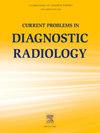The history of Women in Radiology (WIR) programs at two academic institutions: How we did it and how we merged best practices
IF 1.5
Q3 RADIOLOGY, NUCLEAR MEDICINE & MEDICAL IMAGING
引用次数: 0
Abstract
Rationale
The percentage of women in radiology has remained at 25 % for decades. Our institutions identified the need to recruit, support and retain women in our departments in order to change this status quo.
Methods
Our institutions created two different frameworks for Women in Radiology (WIR) programs in order to meet the needs of each distinct department. The organizational structure (trainee led vs faculty led and hybrid), the need for departmental chair support, and types of events and speakers are outlined with unique programs provided by each institution. Collaboration with established programs for women within the institutions and within the region was utilized to support the developing programs.
Results
Each of the (WIR) programs has been successful in creating community, impact and sustainable programming, including a peer and faculty mentoring programs for all genders, improvements in gender equity in the workplace, the implementation of trainee parental support programs, and an overall increase in the percentage of women trainees and faculty. Over the last 3 years, the integration of the two programs into a single Women in Radiology program, also encompassing the new enterprise radiology group, has led the way during the initiation of a large institutional merger from two institutions to one large institution.
Outcomes
We have provided two frameworks for developing a successful women in radiology program as well as a roadmap for combining best practices in a time of change and institutional merger at a major academic institution.
两所学术机构的放射科女性(WIR)计划的历史:我们是如何做到的?
理由几十年来,放射科的女性比例一直保持在 25%。为了改变这一现状,我们的机构认为有必要招募、支持和留住本部门的女性。方法我们的机构为放射科女性(WIR)计划创建了两个不同的框架,以满足每个不同部门的需求。组织结构(受训者主导与教员主导及混合型)、对系主任支持的需求以及活动和演讲者的类型都由各机构提供的独特计划进行了概述。结果每个(WIR)计划都成功地创建了社区、产生了影响并实现了可持续发展,包括针对所有性别的同行和教员指导计划、工作场所性别平等的改善、受训人员父母支持计划的实施以及女性受训人员和教员比例的整体提高。在过去的 3 年中,我们将两个项目整合成了一个 "放射科女性 "项目,其中还包括新成立的企业放射学组,在从两个机构合并成一个大型机构的过程中起到了带头作用。我们为发展一个成功的放射科女性项目提供了两个框架,也为一个大型学术机构在变革和机构合并时结合最佳实践提供了一个路线图。
本文章由计算机程序翻译,如有差异,请以英文原文为准。
求助全文
约1分钟内获得全文
求助全文
来源期刊

Current Problems in Diagnostic Radiology
RADIOLOGY, NUCLEAR MEDICINE & MEDICAL IMAGING-
CiteScore
3.00
自引率
0.00%
发文量
113
审稿时长
46 days
期刊介绍:
Current Problems in Diagnostic Radiology covers important and controversial topics in radiology. Each issue presents important viewpoints from leading radiologists. High-quality reproductions of radiographs, CT scans, MR images, and sonograms clearly depict what is being described in each article. Also included are valuable updates relevant to other areas of practice, such as medical-legal issues or archiving systems. With new multi-topic format and image-intensive style, Current Problems in Diagnostic Radiology offers an outstanding, time-saving investigation into current topics most relevant to radiologists.
 求助内容:
求助内容: 应助结果提醒方式:
应助结果提醒方式:


